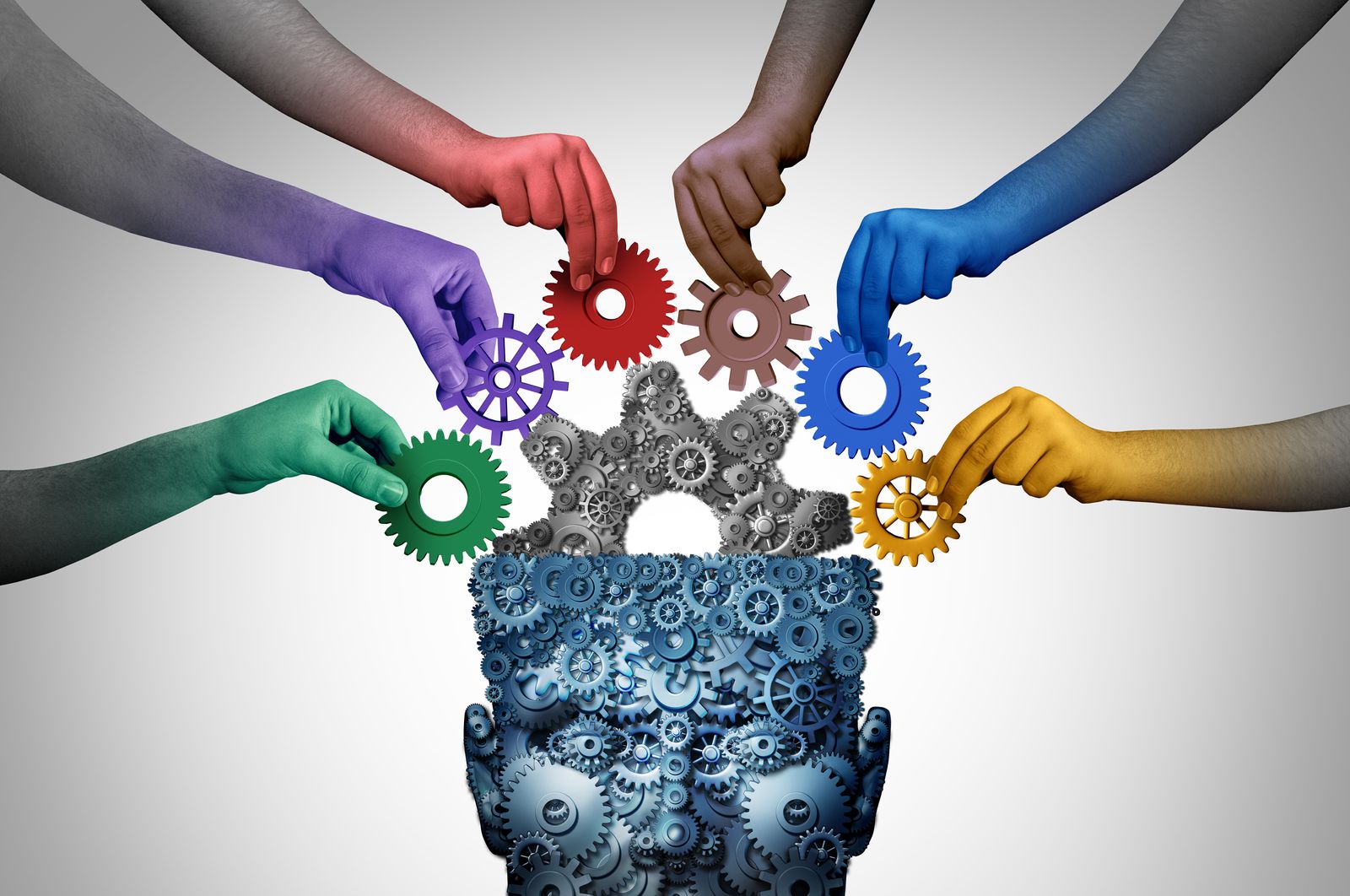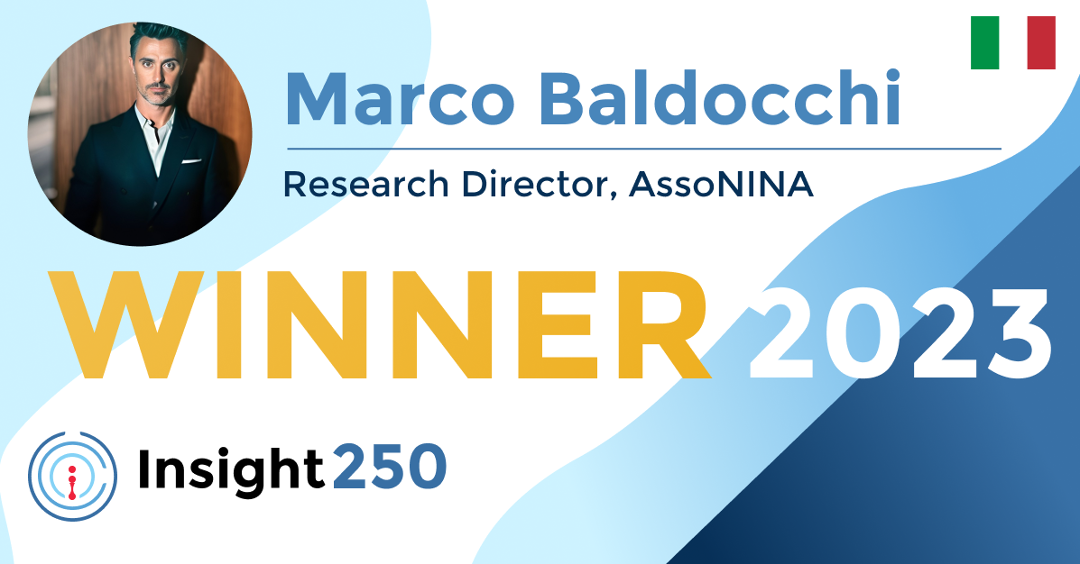Neural Mechanisms Behind Consumer Decision-Making
The Insight250 series showcases exceptional professionals and this time, Crispin spoke with Marco Baldocchi about the fascinating neural mechanisms behind consumer decision-making.

Article series
Insight250
- The importance of business sense in research
- The role of humour in effective leadership
- The importance of ethics
- The importance of disruption in innovation and leadership
- The importance of Disruption in Innovation and Leadership Part 2
- The importance of Diversity & Inclusion
- The impact of colour
- Communicating insight with impact
- Insights on leadership, culture and polling
- The evolution of electric vehicles
- 2022 Top tips (part 1)
- 2022 Top tips (part 2)
- Maximising the potential of data
- The importance of flexible working
- Winners
- The importance of advanced analytics
- Judges for the 2022 Insight250 Awards announced
- The evolution from social listening to digital intelligence
- The Judges' Perspective
- The judge's perspective - part 2
- Insight Climate Collective
- Insights technology
- Understanding employee ownership
- Global insight perspectives
- Top Tips from our Leaders and Innovators
- The Evolution of Insights in the Food & Beverage Market
- The Evolution of Insights in CPG
- Neural Mechanisms Behind Consumer Decision-Making
- Celebrating and Elevating the Insights Industry
- The State of the Insights Industry
- Opportunities, challenges and threats that AI presents
- 2024 Insight250 Winners Announcement
- Connecting Brands and Consumers Through Insights
- The Importance of Human Insight and Attention
- The Elevating Role of Insights with Technology Innovation
- Haleon’s Insight Expert on Consumer Healthcare
- Insight from the Insight250: How AI is Impacting Qualitative Research
- How AI Tech is Doing the ‘Heavy Lifting’ for Insights
- Reviewing the top tips for 2025
- Google's Sarah Ashley on AI and revolutionising insights - Insights from the Insight250
- Beyond BI: The Future of Decision Intelligence for Insight Professionals
- The Advancement & Impact of Insights - An Insight250 Winners Series perspective with David Smith
- International Jury for the 2025 Insight250 Awards Announced
- Newly elected President, Anne-Sophie, on Revolutionizing the Impact of Insights
- Haleon's Litthya Baez on Enhancing Healthcare with Insights - Insight250 Winners Series
- Understanding the Insights of Consumer Decisions
- Moving Beyond Dashboards to Deliver Decisions with AI
- How AI is Transforming Insights
- How AI is Transforming Insights
- Five Years of Insight250: Elevating the Insight Industry
The Insight250 spotlights and celebrates 250 of the world’s premier leaders and innovators in market research, consumer insights, and data-driven marketing. The awards have created renewed excitement across the industry whilst strengthening the connectivity of the market research community. Winners of the 2024 Insight250 will be announced at the ESOMAR Congress in Athens this September - a full list of previous winners can be seen at Insight250.com.
With so many exceptional professionals named to the Insight250, it seems fitting to tap into their expertise and unique perspectives across various topics. This regular series does just that: inquiring about the expert perspectives of many of these individuals in a series of short topical features.
This edition features Marco Baldocchi the Neuromarketing Research Director of the Italian National Association of Applied Neuroscience. He also teaches consumer behaviour and neuromarketing at Università Cattolica del Sacro Cuore. Marco and I had an in depth conversation about the neural mechanisms behind consumer decision making. In my opinion behavioral science is fundamental to research and insight so delving in depth into these areas, that I use day to day with the teams at Behaviorally, with an expert like Marco, was truly fascinating. I hope everyone finds this as interesting as I did - enjoy.
Thank you Marco.
Crispin: What are the key neural processes involved in consumer choices?
MB: “To explain the neural processes involved in consumer choices, we must acknowledge that our brain is a complex blend of irrational and rational elements. Research has shown that 95% of our decision-making processes are unconscious, initiated by sensations and driven by emotions. It is only after this emotional response that we rationalize our decisions. This doesn't mean that an emotion alone is enough to convince someone to make a purchase, but it is certain that without an emotional trigger, the consumer process cannot begin.
“Consumer decision-making involves several key neural mechanisms:
• Reward Processing: Brain regions like the ventral striatum process rewards, influencing decisions by seeking positive outcomes.
• Emotional Regulation: The amygdala and prefrontal cortex manage emotions that impact preferences and choices.
• Memory and Learning: The hippocampus helps recall past experiences, affecting current decisions.
• Social Influence: The medial prefrontal cortex considers social factors like peer opinions and brand image.
• Cognitive Control: The dorsolateral prefrontal cortex aids in attention, planning, and inhibiting impulsive choices.
• Value Assessment: The ventromedial prefrontal cortex integrates emotional and cognitive evaluations to guide decisions.
• Decision Conflict: The anterior cingulate cortex resolves conflicts between competing choices.
• Visual Processing: Visual areas process sensory information about products, influencing preferences.
• Dopamine System: Dopamine reinforces decisions and shapes future preferences through reward processing and motivation. These mechanisms work together to influence how consumers evaluate options and make choices.”
Crispin: How can understanding these processes improve marketing strategies?
MB: “Understanding these processes helps marketers improve their strategies by leveraging insights into human behavior. While we often talk about AI today, it's crucial to remember that the final decision to buy or not is made by a human being—one who is inherently irrational and emotional.
“When we're in the process of making a decision, we experience what I call a "cognitive cruise," a phase where our irrational and rational systems interact and sometimes conflict to guide us to a final choice. The extent to which we rely on one system over the other depends on various factors, including the significance of the decision at hand.
“Recognizing what occurs in the minds and bodies of consumers during this cognitive cruise is essential for optimizing marketing strategies. By understanding the neural mechanisms at play, marketers can create more effective campaigns that resonate with both the emotional and rational aspects of consumer decision-making. This insight enables marketers to design strategies that not only capture attention but also drive engagement and ultimately, conversions.”
Crispin: How do emotional and cognitive factors interplay to affect purchasing decisions?
MB: “The interplay between emotional and cognitive factors significantly impacts consumer behavior and purchasing decisions. Emotions often serve as initial triggers, influencing perceptions and creating positive impressions of products or brands. For instance, advertisements that evoke joy or nostalgia can make consumers more likely to consider a purchase. Emotions also foster brand loyalty by consistently generating positive feelings.
“Cognitive factors come into play as consumers evaluate options more rationally, considering features, price, quality, and overall value. This logical assessment helps them make informed decisions. For example, a consumer might be drawn to a luxury car due to its design (emotional factor) but will also consider fuel efficiency and cost (cognitive factors) before purchasing. Effective marketing strategies integrate both emotional and cognitive appeals. Campaigns that create emotional connections and provide clear, logical reasons for buying tend to be more successful. For instance, emotional storytelling combined with data and facts can lead to higher conversion rates.
“By understanding the balance between emotion and cognition, marketers can craft messages that appeal to the whole consumer, ensuring their campaigns resonate emotionally while providing the information needed for rational decision-making. This approach more effectively influences consumer behavior and drives sales.”
Crispin: What role does subconscious processing play in consumer behavior?
MB: “Subconscious processing plays a crucial role in consumer behavior, especially in the use of the senses. For example, the sense of smell is processed directly by the brain's emotional and memory centers, bypassing the rational thinking areas. This direct pathway to the limbic system, which includes the amygdala and hippocampus, explains why scents can evoke strong emotions and vivid memories instantly. Unlike other senses that undergo rational analysis, smells trigger instinctive and emotional responses. Marketers can leverage this by using evocative scents to create positive associations with their products, enhancing consumer experiences on a subconscious level. And this is just one example.”
Crispin: How does the brain perceive value, and what neural factors influence this perception?
MB: “Principally, as emotional beings, we are influenced by internal and external factors. Internally, our reward system, emotional processing, cognitive evaluation, and memory and past experiences all play significant roles. Externally, contextual factors and anchoring effects shape our perception of value and pricing. Additionally, we are inherently selfish and lazy creatures; our brain is often referred to as a "cognitive miser." We perceive value based on how well a product or service meets our needs, especially our unconscious needs—those latent desires we have but cannot easily articulate. These are the most important because when they are satisfied, they create a deep emotional connection with the brand, making us fall in love with it.
Crispin: How can businesses optimize pricing strategies using insights from neuroscience?
MB: “Through neuromarketing research, using tools like electroencephalograms (EEG), eye tracking, and galvanic skin response, we can understand what happens in the consumer's brain and uncover their unconscious perception of price. Asking a consumer how much they are willing to spend on a product is like a waiter asking, "How was your dinner?" Have you ever answered negatively? And yet, have you always had a great meal? This discrepancy occurs due to cognitive biases, which are systematic patterns of deviation from norm or rationality in judgment. Cognitive biases affect how we perceive and respond to information, often leading to responses that do not accurately reflect our true feelings or experiences. Understanding these biases allows marketers to better interpret consumer behavior and preferences.
Crispin: What are the most effective sensory marketing techniques based on neuroscientific research?
MB: “Sensory marketing techniques leverage the power of our senses to create more engaging and memorable consumer experiences. Based on neuroscientific research, combining multiple sensory elements can create a more immersive and engaging experience. For example, a coffee shop might use the aroma of freshly brewed coffee, comfortable seating, ambient music, and visually appealing décor to create a holistic experience that encourages customers to stay longer and return frequently, does it sound familiar?
Neuroscientific research shows that engaging multiple senses simultaneously can create stronger and more positive emotional responses. This multisensory engagement can lead to better brand recall, increased customer loyalty, and higher sales. By understanding how different sensory inputs affect consumer behavior, marketers can design strategies that more effectively capture and hold consumer attention, creating memorable and enjoyable experiences.
Crispin: How do sensory experiences enhance brand perception and loyalty?
MB: “Sensory experiences enhance brand perception and loyalty by engaging multiple senses, creating a more immersive and memorable interaction with the brand. When a brand strategically incorporates elements such as sight, sound, touch, taste, and smell, it can evoke emotions and create positive associations.
The process from sensation to perception to memory involves several steps:
1. Sensation: Sensory receptors detect stimuli (e.g., a pleasant scent or a vibrant color).
2. Perception: The brain organizes and interprets these sensory inputs, forming a coherent image or understanding (e.g., associating the pleasant scent with a relaxing store environment).
3. Memory: These perceived experiences are encoded into memory, allowing for later recall and influencing future behavior (e.g., remembering the pleasant store when deciding where to shop next).
These sensory cues help differentiate the brand from competitors, making it more distinctive and easier to recall. Over time, consistent and positive sensory experiences build an emotional connection with consumers, fostering trust and loyalty. This multi-sensory approach not only enhances the overall customer experience but also strengthens the brand's identity, leading to increased customer retention and advocacy.”
Crispin: What are the latest tools and technologies in neuromarketing research?
MB: “Technology is greatly aiding the world of neuromarketing, making it more accessible to any company, not just large brands. AI, which is becoming increasingly "trendy," is also helping this field grow by speeding up data analysis and cleaning.”
Crispin: How can these advancements provide deeper insights into consumer behavior?
MB: “These developments primarily help in the speed with which an agency like ours can provide accurate data to our client companies. Too often, the academic world in this field is very slow, while the business world, on the contrary, needs fast and precise data. Technology helps us collect, clean, and read data, which is then interpreted quickly without losing the quality of the data itself.
Crispin: Can you provide examples of successful marketing campaigns informed by neuroscience?
MB: “There are many cases where neuroscience has helped brands. In our case, I can narrate two examples. An Italian product company selling in the American market struggled to penetrate the market. After analyzing clusters of potential customers, we found that the most emotionally and cognitively relevant factor in the brand's history was not "Made in Italy," but the fact that every year the founder, an American, would go to Italy to talk with small suppliers, look them in the eyes, shake their hands, and import the products to the US. The handshake gesture turned out to be the most emotional. The company shifted its strategy to focus on the concept of the handshake, and after a year, the results were astounding: a 464% increase in sales, without mentioning "Made in Italy."
Another case of history is related to the real estate world. An important building in Miami was offering pre-construction apartments for sale, with a marketing strategy focused on selling luxury. However, in Miami, luxury apartments are common. In this case, the uniqueness was the building's strong connection to the holistic world. Research on clusters of potential clients uncovered some unconscious needs, such as belonging to a community of people who love a holistic lifestyle, having "neighbours" with similar passions, or seeking a "safe and calm nest" in their apartment compared to the chaotic city of Miami. This was also true for people from even more chaotic cities, like New York, who had chosen Miami as a peaceful destination, but upon realizing it wasn't as peaceful as expected, sought that tranquility in their lifestyle.
We have worked with many companies that, for example, asked us to analyze the perceived price by their customers, meaning how much they would be willing to pay for their product unconsciously, influenced only by packaging, advertising, or social communication.
TOP-TIP:
Crispin: What's your top tip to be a leader & innovator in our profession?
I believe in the power of curiosity. Curiosity is the key to evolution. Being curious drives you to understand what happens in consumers' minds when they have an experience. We are emotional beings who rationalize our emotions, and our reactions can be both fascinating and surprising. My suggestion, or rather my top tip, is this: be curious. Push yourself beyond the limits of your curiosity, and you will discover amazing answers.
Crispin: Marco, thank you for this in-depth conversation on such a fascinating topic and for sharing your expertise in this realm. It is incredible to see the advancements in neuroscience and its impact on the role of insights in understanding the mind of the consumer.

Crispin Beale
Chairman at QuMind, CEO at Insight250, Senior Strategic Advisor at mTab, CEO at IDXCrispin Beale is a marketing, data and customer experience expert. Crispin spent over a decade on the Executive Management Board of Chime Communications as Group CEO of leading brands such as Opinion Leader, Brand Democracy, Facts International and Watermelon. Prior to this Crispin held senior marketing and insight roles at BT, Royal Mail Group and Dixons. Crispin originally qualified as a chartered accountant and moved into management consultancy with Coopers & Lybrand (PwC). Crispin has been a Board Director (and Chairman) of the MRS for nearly 20 years and UK ESOMAR Representative for c15 years. As well as being CEO of Insight250, Crispin is currently Worldwide CEO of Digital Communications Solution Agency, IDX. Crispin is also the Senior Strategic Advisor at mTab and the Chairman of QuMind and spent 4 years as Group President of Behaviorally where he was responsibile for the client & commercial teams globally. Crispin is a passionate advocate for blending human intelligence and technology to deliver innovation and leadership across organisations.
Article series
Insight250
- The importance of business sense in research
- The role of humour in effective leadership
- The importance of ethics
- The importance of disruption in innovation and leadership
- The importance of Disruption in Innovation and Leadership Part 2
- The importance of Diversity & Inclusion
- The impact of colour
- Communicating insight with impact
- Insights on leadership, culture and polling
- The evolution of electric vehicles
- 2022 Top tips (part 1)
- 2022 Top tips (part 2)
- Maximising the potential of data
- The importance of flexible working
- Winners
- The importance of advanced analytics
- Judges for the 2022 Insight250 Awards announced
- The evolution from social listening to digital intelligence
- The Judges' Perspective
- The judge's perspective - part 2
- Insight Climate Collective
- Insights technology
- Understanding employee ownership
- Global insight perspectives
- Top Tips from our Leaders and Innovators
- The Evolution of Insights in the Food & Beverage Market
- The Evolution of Insights in CPG
- Neural Mechanisms Behind Consumer Decision-Making
- Celebrating and Elevating the Insights Industry
- The State of the Insights Industry
- Opportunities, challenges and threats that AI presents
- 2024 Insight250 Winners Announcement
- Connecting Brands and Consumers Through Insights
- The Importance of Human Insight and Attention
- The Elevating Role of Insights with Technology Innovation
- Haleon’s Insight Expert on Consumer Healthcare
- Insight from the Insight250: How AI is Impacting Qualitative Research
- How AI Tech is Doing the ‘Heavy Lifting’ for Insights
- Reviewing the top tips for 2025
- Google's Sarah Ashley on AI and revolutionising insights - Insights from the Insight250
- Beyond BI: The Future of Decision Intelligence for Insight Professionals
- The Advancement & Impact of Insights - An Insight250 Winners Series perspective with David Smith
- International Jury for the 2025 Insight250 Awards Announced
- Newly elected President, Anne-Sophie, on Revolutionizing the Impact of Insights
- Haleon's Litthya Baez on Enhancing Healthcare with Insights - Insight250 Winners Series
- Understanding the Insights of Consumer Decisions
- Moving Beyond Dashboards to Deliver Decisions with AI
- How AI is Transforming Insights
- How AI is Transforming Insights
- Five Years of Insight250: Elevating the Insight Industry


